 Yet when I was there,
walking around, I felt a flood of negative feelings. At first I didn't
really know why. Then I realized that it was because I felt immediately
cast into a set role of White Tourist with Dollars, which put me on the
defensive. The market seems to be catered to the visiting foreigner who
wants a material representation of Cuba -- I saw people all around me
shelling out their dollar bills for the cheesiest commodities. The setting
seemed to lock everyone in the expected roles (either The Cuban/Seller or
The Visitor/Buyer), defining the relationship between the two by the actions
of selling and buying. I felt like I couldn't really relate to any local
Cubans in a human way since I was being viewed as an objectified outsider, a
buyer with American dollars in my pocket. Perhaps I
was merely projecting my own perceptions, responsible for locking myself
into a self-created part; in truth, I have no idea how the Cuban craftspeople
were assessing me.
Yet when I was there,
walking around, I felt a flood of negative feelings. At first I didn't
really know why. Then I realized that it was because I felt immediately
cast into a set role of White Tourist with Dollars, which put me on the
defensive. The market seems to be catered to the visiting foreigner who
wants a material representation of Cuba -- I saw people all around me
shelling out their dollar bills for the cheesiest commodities. The setting
seemed to lock everyone in the expected roles (either The Cuban/Seller or
The Visitor/Buyer), defining the relationship between the two by the actions
of selling and buying. I felt like I couldn't really relate to any local
Cubans in a human way since I was being viewed as an objectified outsider, a
buyer with American dollars in my pocket. Perhaps I
was merely projecting my own perceptions, responsible for locking myself
into a self-created part; in truth, I have no idea how the Cuban craftspeople
were assessing me.
"Now I am the gun
And you are the bullet
I got the power and glory!
(Puzzling)
And the money to buy it!
(Puzzling)
Got your Gulf and Western and your MasterCard
(Puzzling Evidence)
Got what you wanted, lost what you had
(Puzzling Evidence)"
Isn't that appropriate? Kitson writes that the seller can look at the
methods used by an evangelist to sell religion, which begins by "showing the
prospective convert (buyer) how great a lack there is in his life" (Bowlby,
103). This idea corresponds to the last line in the quote above from
"Puzzling Evidence," as the church-goers sing about losing what you once
owned.
I was born in a house with the television always on
And you're rolling
Now love is here
You can put your lipstick all over my designer jeans.
Push my button...
And now love is here
Love is here
LOVE FOR SALE
Guess I grew up too fast
And I forgot my name
We're in cities at night and we got time on our hands.
So leave the driving to us.
And it's the real thing.
In the blender
With me.
And I can love you
Like a color
TV.
C'mon and try it
I got love for sale
Got love for sale
And now love is here
C'mon and try it
Got love for sale,
Got love for sale.
I'll be a video for you.
If you turn my dial.
You can cash my check if you go down to the bank
You get two for one
For a limited time.
The toast pops up
Love and money
Gettin' all
Mixed up
C'mon and try it.
I got love for sale
Got love for sale
C'mon and try it
I got love for sale
I got Love
Love
Love
Love
Love
Love
Love
Love